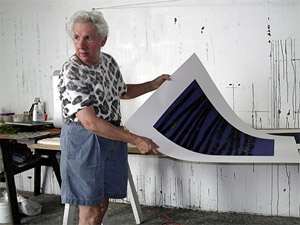 |
|
A Tribute Sheila Marbain
By Sandy Walker
I met Sheila relatively late in her life, about 1996, through good fortune and random circumstances. I was able to work with her for periods of a week or two over the next several years and became her friend. How could one not be Sheila's friend? She was so lovely, gentle, and unimposing. And, if you were an artist, she was absolutely supportive. I remember well how she loved to collaborate. When she and I would find a working rhythm, when she would discover what it was that I was trying to do, when I would start to understand the media and the special means she was offering, she would get a most wonderful twinkle in her eye. Her body would be visibly energized, and a skip would start to appear in her every step. Together we would start to take off and fly in the way creative people understand and live for. And, of course, she was as delighted as I when some surprising wonder would appear as the screen lifted from the paper. And, when the hoped for masterpiece did not appear, Sheila was always there with her honest counsel plus her most encouraging and willing efforts to push on. I only gradually came to know Sheila's historic importance, that she had worked significantly with most of the famous artist of the sixties and seventies, Indiana, Wesselman, Rauschenberg, Oldenburg, Warhol, Poons, Motherwell and Frankenthaler to name just a few. Associations with famous and successful artists were not what Sheila was about. She was an artist's printer, a friend to the artist, a devotee to the arts and to the creative process in the highest sense. Sheila had attended Black Mountain College in its heyday and studied with Albers, Bolotowsky, and deKooning from 1948-50. She and her first husband Ary Marbain had elevated silkscreen printing out of commercial context and into the fine arts realm. Her accomplishments were significant and notable. Her work with artists was recognized and exhibited widely and is archived at the Jane Voorhees Zimmerli Art Museum at Rutgers University, New Brunswick, NJ. But for Sheila those accomplishments were not enough to make her life fulfilled, and by the early 1990's she had abandoned edition printing for the unique and secret formula she discovered to create silkscreen monotypes, a process that she regarded as far more exciting and creative than her earlier work. Artist Katherine Kadish, summing up what we all felt when we worked with Sheila in those later years, wrote, "Sheila was an island of calm, grace, and good humor in the midst of New York City. For artists she was a sounding board, a friend and technician. She provided enormous experience, was immensely supportive to her 'artists' and was always interested in their work and achievements, but completely uninterested in the competitive hustle of the 'art world.' What mattered to Sheila was the work and her relationship to the artists. To those who encountered her Sheila was a 'National Treasure.'" In her later years Sheila lost her studio on Warren Street and with the generosity and reverence of Bob Blanton of Brand X Editions was given an alcove of their larger studio on Canal Street where she could work with all her integrity while the mass production of large editions of fine arts prints by Neiman, Katz, Close, and others were turned out by a crew of seemingly hundreds of workers. All those workers seemed to hold Sheila in complete awe, as did Bob himself who sheltered her for many years. My work with Sheila had not ended. As I am sure is true with many who worked with her in her later years. There were always new projects and new ideas to be explored with Sheila. One time I helped her to come to California to share her methods with print artists there. She was already well into her 70s, but she was always ready for the adventure. Sheila is now gone. Our work is unfinished. But such is also the creative process. Sheila shared fully with us the live wire of her energy. Sheila is gone, but her energy remains and inspires us.
| |||||||||||||||||||||||||||||||||||||||
| home | news | resume | bibliography | paintings | works on paper | wood block | silkscreen | statements | contact |
